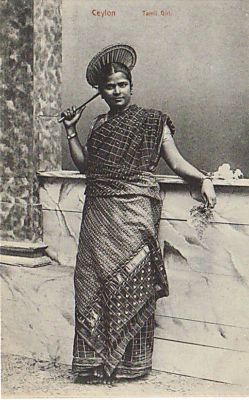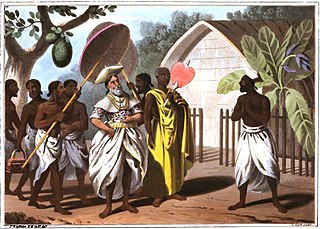The SiamNikaya is a monastic order within Sri Lankan Buddhism, founded by Upali Thera and located predominantly around the city of Kandy. It is so named because it originated within Thailand. The Siyam Nikaya has two major divisions and five other divisions within these two major units. The Malwatta and Asgiriya chapters have two separate Maha Nayakas or chief Monks.

The Amarapura Nikaya was a Sri Lankan monastic fraternity founded in 1800. It is named after the city of Amarapura, Burma, the capital of the Konbaung dynasty of Burma at that time. Amarapura Nikaya monks are Theravada Buddhists. On 16 August 2019, the Amarapura and Ramanna Nikaya were unified as the Amarapura–Rāmañña Nikāya, making it the largest Buddhist fraternity in Sri Lanka.

Indian Tamils of Sri Lanka are Tamil people of Indian origin in Sri Lanka. They are also known as Malayaga Tamilar, Hill Country Tamils, Up-Country Tamils or simply Indian Tamils. They predominantly descend from workers sent from Southern India to Sri Lanka in the 19th and 20th centuries to work in coffee, tea and rubber plantations. Some also migrated on their own as merchants and as other service providers. These Tamil speakers mostly live in the central highlands, also known as the Malayakam or Hill Country, yet others are also found in major urban areas and in the Northern Province. Although they are all termed as Tamils today, some have Telugu and Malayalee origins as well as diverse South Indian caste origins. They are instrumental in the plantation sector economy of Sri Lanka. In general, socio-economically their standard of living is below that of the national average and they are described as one of the poorest and most neglected groups in Sri Lanka. In 1964 a large percentage were repatriated to India, but left a considerable number as stateless people. By the 1990s most of these had been given Sri Lankan citizenship. Most are Hindus with a minority of Christians and Muslims amongst them. There are also a small minority followers of Buddhism among them. Politically they are supportive of trade union-based political parties that have supported most of the ruling coalitions since the 1980s.
The caste systems in Sri Lanka are social stratification systems found among the ethnic groups of the island since ancient times. The models are similar to those found in Continental India, but are less extensive and important for various reasons. Modern times Sri Lanka is often considered to be a casteless society in south asia.

Sri Lankan Tamils, also known as Ceylon Tamils or Eelam Tamils, are Tamils native to the South Asian island state of Sri Lanka. Today, they constitute a majority in the Northern Province, form the plurality in the Eastern Province and are in the minority throughout the rest of the country. 70% of Sri Lankan Tamils in Sri Lanka live in the Northern and Eastern provinces.
Koviyar is a Tamil caste found in Sri Lanka. They are traditional agriculturalists and temple workers but also included merchants, landowners and temple patrons. Kattavarayan as caste deity is observed by the Koviar. They are reputed as a ritually dominant caste and regarded as the "cousin" caste of the more numerical dominant caste, Sri Lankan Vellalar.
Demalagattara are a social group or caste amongst the Sinhalese of Sri Lanka. Demalagattara are Theravada Buddhists by religion. They are ethnically Sinhalese but proclaim their Tamil ethnic origins, whereas all other South India-derived castes such as Karave, Salagama, Durave and Berava do not emphasise their Tamil links as part of their assimilation into Sinhalese society.
Govigama is a Sinhalese caste found in Sri Lanka. They form approximately half of the Sinhalese population and are traditionally involved in agriculture. The term Govigama became popular during the last period of the Sinhalese Kingdom of Kandy. Its members have dominated and influenced national politics and Sinhalese Buddhism.

Radala refers to a small minority group in Sri Lanka in the former provinces of the Kingdom of Kandy, who are either descendants of chiefs and courtiers of the King of Kandy of Nayaks of Kandy or descendants of native headmen appointed by the British colonial administration following the Uva Rebellion in 1818.
Hēna, also Radā, is a minority Sinhalese caste. "Rajas" means dirt in Sinhala and Pali or Sanskrit and "Rajaka" means the removers of dirt. They collected cloths by traveling home to home of higher castes but now that was obsolete in Sri Lanka.but still they performs several rituals in the weddings and the females of this caste performs vital role in the puberty rituals of Radala and Govigama people in some areas of Sri Lanka. They called "Redi nanda" for females and "Hene mama" for males by the Sri Lankan society because they were given some respect unlike the other Asian countries due to the influence of buddhism in early periods.
Bathgama a Sri Lankan caste predominantly in the Kandyan provinces, the traditional occupation of which was the cultivation of rice paddy. Hence the name Bath (rice) and Gama (village) in the Sinhala language.
The Porowakara were a minority community of wood cutters from Sri Lanka. They were a part of the feudal land tenure system of Sri Lanka but eventually became absorbed into larger communities.
Patti is a traditional caste of Herdsmen from Sri Lanka’s feudal past. They were a part of the feudal land tenure system and a sub-caste of the Govigama caste. Found in the highlands and the maritime provinces but now mostly merged into the Govigama caste.
Sri Lankan Vellalar is a caste in Sri Lanka, predominantly found in the Jaffna peninsula and adjacent Vanni region, who comprise about half of the Sri Lankan Tamil population. They were traditionally involved in agriculture, but also included merchants, landowners and temple patrons. They also form part of the Sri Lankan Tamil diaspora.

Gamperaliya is a novel written by Sri Lankan writer Martin Wickremasinghe and first published in 1944. Wickremasinghe subsequently wrote Kaliyugaya and Yuganthaya, as a trilogy encompassing three generation of the same family and the changing society, culture and economic environment of Sri Lanka between the early and mid 20th century.
Social class in Sri Lanka is often described as casteless, though caste is still found on the island in both a symbolic and a practical sense. Caste is also used in an analogous sense to refer to the new social class divisions that have appeared in recent decades. The combination of ethnic nationalist movements that saw caste as an island-wide dividing tool, strong emphasis on providing access to education and healthcare regardless of background, and historic lack of discrimination among the colonial civil service played a factor in eradicating the caste system in most sectors of the island's society. Although the Buddhist culture actively fought against all forms of class discrimination, many Buddhist organizations used caste as a method to extract surplus from temple property.
Indians in Sri Lanka refer to Indians or people of Indian ancestry living in Sri Lanka, such as the Indian Tamils of Sri Lanka.

Tamil settlement of Sri Lanka refers to the settlement of Tamils, or other Dravidian peoples, from Southern India to Sri Lanka. Due to Sri Lanka's close proximity to Southern India, Dravidian influence on Sri Lanka has been very active since the early Iron Age or megalithic period.
Mukkuvar is a maritime ethnic group found in the Indian states of Kerala, Tamil Nadu and the Eastern and North Western coastal regions of Sri Lanka. They are mostly found on the Malabar Coast, South Travancore Coast and Kanyakumari district, Tamil Nadu, who have traditionally been involved in fishing and other maritime activities.
Weerasooriya is a Sinhalese surname, with origins tracing back to South of Sri Lanka. The word Weera means brave or hero, and sooriya is meant to denote the ancestry and descent from the Kshatriya Solar Dynasty, which is quite common among Karava, even Govigama Names.





